
























NATE SCHWARTZ Coos Bay World
Not all rescues are the result of accidents or disasters. Some come through close communication and coordination with vessels at sea when one of their passengers need immediate assistance. That was the case on Easter Sunday, when the M/V National Geographic Venture, a small cruise ship designed for wild life excursions, had a crew member fall violently ill.
The 30-year-old was 15 miles off shore and in need of immediate medical attention, through communication with Coast Guard Sector Columbia River and their flight surgeon it was determined he should
be medevacked via helicopter.
That’s where the crew from Air Station North Bend comes in. On the forefront of most air operations along the South Coast, the crew are no strangers to a daring rescue. In this case, the MH65 Dolphin crew was dispatched to rendezvous with the cruise ship. They send down the basket and the crew members was transported safely to Bay Area Hospital for treatment in stable condition.
“Safe and efficient medical evacuations of mariners are only possible through closely coordinated efforts from start to finish” said Lt. Christopher Saylor, Search and Rescue Mission Coordinator,
Sector Columbia River.
“The expert coordination between the flight crews, vessel master, and watchstanders resulted in a successful outcome for the patient”
While medical evacuations are not uncommon, they are a bit more routine. That was not the case for a rescue the month prior.
In the dead of night, a 71-year-old woman lost control of her vehicle and ended up in the white water of the McKenzie River outside of Eugene and things looked dire. Crews from the local fire and police departments were on scene quickly, but it was clear that there was no
See NORTH BEND Page 3



















the rescue, as AST2 Tyler Gantt, the rescue swimmer, was lowered right down onto the roof of the car.
way to get to the car given the precarious swiftness of the water. That’s when, once again, the specialized training of North Bend’s Dolphin helicopter crew was needed.
Having just finished a training exercise, the duty crew received a text that they were needed and they arrived as quickly as they could.
“As we got overhead and the swimmer got to the [helicopter] door, he noticed that the water was not being redirected by the car. The car was wedged on the rocks and water was actually flowing underneath the car as well. The swimmer also recognized the car had a sun roof,” explained Lt. Cdr. Kevin Shanahan, the flight commander.
“Once I got my feet planted on the hood, I could feel the car moving. At that point I knew that where it was in the river wasn’t stable, and it wasn’t guaranteed to stay there,” explained Gantt. “I had to switch gears to move quickly. If the car starts to go, I can’t go with it, I’m attached to the helicopter still. So, I knew if the car started to go, I’d have to slide off, they’d have to pick me up and we’d have to start this thing all over again.”
Gantt used his crash axe to make a small crack in the sunroof, issued the woman a warning to keep their head down, and started smashing in the rest.
ms I heard that night was when the flight medic said ‘He’s talking to the survivor and she’s moving’. I knew she was responsive and we were going to get her out of there,” said Shanahan.
And so they did, they were able to lift her into the helicopter and get her safely to emergency medical services at the Eugene Airport. Not after thanking Gantt with a big hug and kiss on the cheek.
“Little things like that make it all worth it for sure. It means everything,” said Lt. JG. Jimmy Hollingsworth, the copilot that night. “Teamwork allaround. What we do requires a lot of trust. Love to trust these guys, we go out there every day and execute it so that we have it down picture perfect.”

That sunroof would be crucial to the rest of



“We prepared that she wouldn’t be responsive when we got down there, but one of the best com -







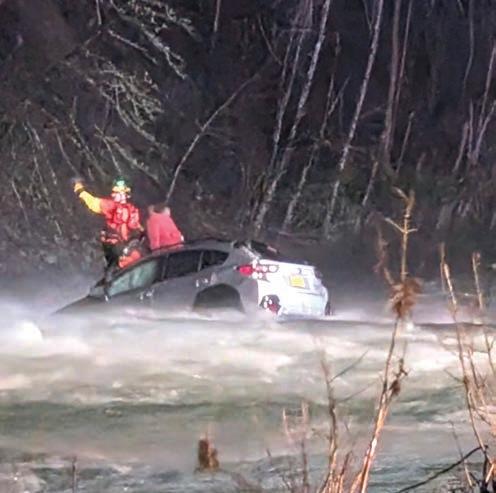








Video of the entire rescue is available on the U.S. Coast Guard Air Station North Bend social media, and is quite the site. Visibility on the river was good that night thanks to the help of the local fire and police crews, which the Coast Guard thanked for their help in a successful operation. Yet another in a long list of rescues for the Dolphin crew.








Even though Coast Guard Station Siuslaw River is currently surrounded by bank reconstruction equipment, its personnel remain ready to help and are dedicated to serving the coast community.
Personnel say the station responds mostly to watercraft disabled by fuel or mechanical issues. However, the station also answers distress calls for missing hikers, kayakers and assists local law enforcement, perform rescues and Station Siuslaw River personnel also serve as law enforcement on the water, responding to everything from boaters under the influence to environmental protection calls.
The station’s area of responsibility is south the Siltcoos River, and north to Cape Perpetua. The station was established in 1917 and
remodeled in the 1980s.
The station also works with personnel from Stations Yaquina River in Newport and Station Umpqua River in Winchester Bay but helps other Oregon Coast Guard stations.
It’s not just the coast of the ocean, but also the rivers and personnel will go all the way to Mapleton if necessary.
The station is staffed by 30 to 36 personnel, using two 47-foot lifeboats and a 29-foot response boat that can easily get there.
If asked, personnel will work with law enforcement agencies Oregon Department of Fish and Wildlife, and park rangers.
While boat personnel don’t assist with inland emergencies as much as the air crews do, USCG helicopter personnel have transported injured loggers from mountain regions.
Coast Guard person-
nel will assist with marine mammal entanglements by helping locate and report the information to rescuers, but does not have divers or personnel specialized to deal with it.
The Siuslaw News conducted interviews with personnel last year at Siuslaw River Station and asked what it’s like to work for the Coast Guard and whether they would recommend it as a career.
Having been with the Coast Guard for 19 years at the time, BM1 Jared Barnes recommended it as a career to high school students considering military or college.
“The Coast Guard is a great way to set your life up for success,” he said, noting that initiatives allow them to save money and have college paid for,
See SIUSLAW RIVER Page 5





From Page 4
as well. “When you get out of the Coast Guard at 22, you’re set up to conquer life.”
Asked what careers one could move into from the Coast Guard, Barnes said, “I think it sets you up for almost any career because it’s just a good work ethic.”
Fireman Aidan Gunderson started his Coast Guard experience at age 20. He said he hopes to move into aviation and feels the Coast Guard is a great first step.
Gunderson said life with the Coast Guard is just like what you see in tv shows and promotional materials, and had exceeded his expectations.
He said days are pretty routine, involving boat
maintenance checks, cleaning and training, as well as studying.
“It’s a really nice environment here,” he said. “Everyone is always willing to help out.”
MK2 engineer Jose Rios spent much of his time inspecting boats and doing maintenance, while also standing ready to answer calls for service.
Towing distressed ves-

sels is common, but Rios said he has also responded to rescues of people from a sinking boat on the ocean and swimmer in distress in the Siuslaw River.
Asked what advice he had for students considering the Coast Guard, he said they should give it a try.
He said it was a dream for him, and learning English was difficult, but he
was able to get in after 10 years.
“It’s been good, I would recommend it,” he said, adding that saving people and being vigilant of their safety has been the most rewarding aspect for him.
“It feels good when people say, ‘thank you for your service,’” he said, “You feel like you’re not here only for your self but you’re here to watch out for your people.”


Asked if he’d like to add a message to the people of Florence, Rios said personnel are here to help.
“We always like to help and if you ever need anything, anyone from the community can come in and ask for help,” he said. “Say, even if you’re moving and you need help putting stuff in your house, we are always willing to help.”






WILL CHAPPEL
Country Media, Inc.
Since 1908, Tillamook Bay and the surrounding waters have been patrolled by personnel from the United States Coast Guard and its predecessor, the Life Saving Service.
Today, 69 Coast Guard personnel are stationed at Coast Guard Station Tillamook Bay in Garibaldi, operating two lifeboats and a skiff to monitor the waters from Tillamook Head to
Cape Kiwanda.
The first station to provide service to Tillamook Bay was built in 1907 and opened in 1908 at Barview Jetty as part of the United States Life-Saving Service, one of the two precursor organizations to the United States Coast Guard, which was formed in 1915. The first station featured a 26foot, manually propelled surfboat that was the only craft stationed in the bay for three decades.
In 1937, the coast guard
began operating from a new boathouse a little over a mile and a half from the mouth of the bay, just west of Garibaldi. Situated at the end of a 650-plus foot pier, the new boathouse featured rails in the floor to facilitate easier launching of the two, new, 36-foot motorboats that arrived a year after the boathouse’s completion in 1936.
The boathouse was manned by around 30 personnel, who continued to live in Barview until 1943,

when new housing was constructed across Highway 101 from the boathouse.
In the mid-1960s, the next generation of boats arrived in Garibaldi, with two 44-foot lifesaving boats originally stationed in the Port of Garibaldi’s boat ba-
sin, before the current boathouse was opened in 1981.
The station’s 39 active-duty personnel, 26 reservists and four civilian personnel primarily focus their training activities on supporting the commercial fishing fleet operating in
their waters, even though recreational craft represent most traffic. In addition to search and rescue operations, the station also conducts law enforcement activities and works to prevent
See TILLAMOOK Page 7
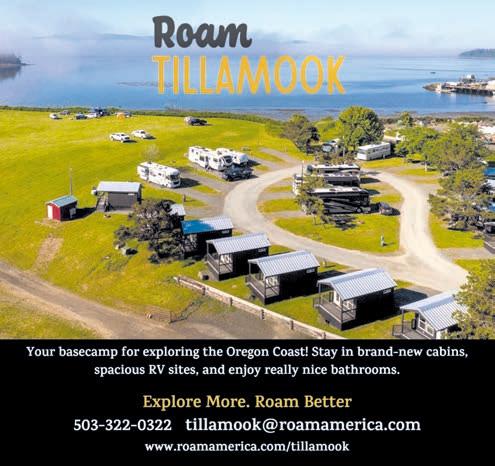
From Page 6
pollution in the marine environment. It is also the duty of the station commander to serve as the Captain of the Port, monitoring harbor access conditions and restricting traffic as necessary.
In addition to these duties, the guard members work to educate locals and visitors to the potential hazards of recreating and boating in the area’s waters.
Two 47-foot motor lifeboats are the main vessels used by the guard members in search and rescue operations, while a skiff is also housed at the station. The motor lifeboats can operate in 20-foot breaking waves and 30-foot seas and have been used in hundreds of rescues off the Oregon and Washington coasts.
The Coast Guard is well embedded in the local community after more than a century, and the community’s support was formally recognized in 2024 when Garibaldi was designated a Coast Guard City, one of 34 across the country. In addition to restoring the historic boathouse, Garibaldians have also promoted Coast Guard history at the Garibaldi Museum and integrated those at the station into the community through traditions such as the annual waterball tournament against local fire crews during the Garibaldi Days festival.





www.garibaldicharters.com





Country Media, Inc.
Located at the end of a quarter-mile pier at the north end of Garibaldi, the Historic United States Coast Guard Boathouse gives visitors a chance to view a unique chapter in the area and guard’s histories.
The boat house was originally constructed between 1935 and 1936 to house two new 36-foot
lifesaving boats, as well as a 26-foot, manually propelled surfboat that had previously been the only vessel stationed in Tillamook Bay. Located at the end of a 650-plus-foot pier, the boathouse previously contained three sets of rails, down which carriages holding the boats would be lowered into the water.
At the time, it was standard practice for the coast guard to construct boat
houses in this manner, according to Denning, although the Tillamook Bay boathouse was the last built using this design.
Operations began at the boat house in 1937, after a delay in procuring the carriages to move the boats prevented a 1936 opening. For the first six years of the boathouse’s existence, guardsmen still lived in the old station in Barview, until new housing opened

across Highway 101 from the boathouse in 1943.
The boathouse’s mission began to scale down in the mid-1960s when two new 44-foot lifesaving boats were stationed at the Port of Garibaldi. For the next decade, the boathouse remained operational as guardsmen used the aging boats for towing practice,
but by the mid-1970s it was decommissioned before ownership was transferred to the Port of Garibaldi in 1980.
After serving as home to several businesses over the next decades, the boat house’s maintenance was turned over to the Garibaldi Cultural Heritage Initiative in 2017, at which point it
became an educational asset for the community. It now features displays on local and coast guard history, as well as tanks with aquatic creatures from Tillamook Bay.
The boathouse is open to the public from noon to 4 p.m. on Saturdays and Sundays between Memorial Day and Labor Day.


The Port of Garibaldi, the commercial fleet and the community appreciate your sacrifice and dedication to keeping safety a priority.


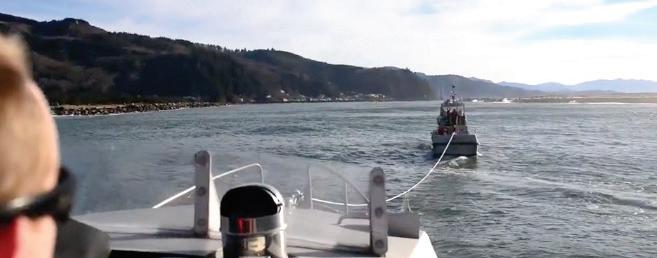
Crewmembers aboard two 47-foot Motor Life Boats from Coast Guard Station Tillamook Bay, Ore., work together during boat towing training in Tillamook Bay, Jan. 14, 2015., Station Tillamook Bay crews are often called upon to respond to boaters in distress off of the Oregon coast, where they will help provide everything from dewatering equipment to conducting the tow of the vessel and ensuring the distressed crew safely returns to port.
MyCG Staff
The U.S. Coast Guard today announced the renaming of its operational districts from numerical to geographic designations, a key initiative under Force Design 2028 (FD2028).
This change will not impact operations or change existing geographical district boundaries.
This strategic change, directed by Secretary of Homeland Security Kristi Noem on May 21, 2025, will help the District names more accurately reflect the regions they serve and represent.
“This renaming is more than just a change in labels; it’s a critical step in our journey to become a more agile, capable, and responsive fighting force,” said Acting Commandant Kevin E. Lunday. “Under Force Design 2028, we are driving fundamental changes to speed decision-making, improve strategic alignment, and ultimately best serve the American people for decades to come. This initiative underscores our commitment to ensuring that change is lasting and has an enduring impact on the Service and the Nation.”
Renaming operational districts revises a numbered

system established during World War II, when the Coast Guard operated as part of the Navy to ensure alignment between the services. In the 80 years since the Coast Guard separated from the Navy, the Service has maintained the numbered districts. However, the Navy stopped using numbered districts over 25 years ago.
Renaming operational districts is a direct action within FD2028’s Organization campaign, which is focused on adapting the Coast Guard’s structure to remain effective and responsive.
This change is a direct action within FD2028’s Organization campaign, which is focused on adapting the Coast Guard’s structure to remain effective and responsive.
To memorialize the updated names for operational districts, the Coast Guard is undertaking the process of formally changing district names in the Code of Federal Regulations. Through this process, the Coast Guard will continue to communicate with stakeholders and provide updated resources and information as appropriate.
Updating operational districts to regional names will more clearly align districts with their areas of responsibility, facilitate collaboration with interagency partners, and ensure the American public and maritime stakeholders can easily find and understand the districts in which they live, recreate, and operate.


Nestled on the beautiful Brookings coast, Station Chetco River is a vital hub for maritime safety along a significant stretch of the Pacific coastline between Oregon and California.
The Coast Guard Station Chetco River was established in 1961 as a direct result of a vote put forth by the citizens of the region who recognized the importance of having an active-duty station in the area.
The geographical service area of the station is wide reaching as it covers from Port Orford down to the Klamath River to include Crescent City, California as it does not have its own Coast Guard station.
With thirty-two active-duty service members, and two reservists, their primary mission is focused on search and rescue and boater safety.
Each morning, the service members start their day
with a quick huddle in order to keep the line of communication open and transparent. They recognize and acknowledge achievements within the crew, then every boat is inspected, cleaned and put through the ringers to ensure all are in top working condition.
Because search and rescue is the primary responsibility of the station, service members rely on
the forty-seven-foot Motor Lifeboats as their primary response vessels.
The workhorse Motor Lifeboats are designed for resilience. They require a minimum of four personnel to operate, can travel fifty to sixty miles offshore and can hold up to thirty people during a search and rescue.
“It takes four people to move the boat in those (open ocean water) conditions,”
explained Colin Chief Joyce. “The guy driving the boat is called the Surfman.”
Amazingly, the Motor Lifeboats can manage waves up to thirty feet. The boats are designed to float and remain upright.
“They are self-righting, so they’ll re-right in eight to ten seconds,” explained Chief Joyce. “They’re fun.
See CHETCO RIVER Page 11



Seaman Connor McBride, Seaman Tristen Kirkaldie, Petty Officer Third Class Zeus Reyes, Fireman Norman Aldridge, Seaman Gunnar Backstrom and Machinery Technician Second Class Omar Rivera. (Front Row): Seaman Talan Zettler, Chief Colin Joyce, Boatswain’s Mate Second Class David Brink, Boatswain’s Mate First Class Adam Delano and Boatswain’s Mate Third Class Taylor Willman.
From Page 10
It’s like if you would stick a football in the water, how that would ride on the water, that’s kind of how these ride. They want to float. They want to stay upright.”
The Surfman will ‘read’ the waves and steer the hull of the boat in a direction that
allows the waves to break in front, or behind, the boat rather than on the boat itself.
“The height of the driver is fourteen feet,” said Chief Joyce, “so you know when you’re looking up at a wave, that’s pretty significant.”
In addition to the Motor Lifeboats, there also is one smaller Quick Response Boat that can hold up to ten people and is used when a
swifter response is required; however, given the size of the boat, it can’t handle any extreme conditions.
“This is one we pretty much use for law enforcement,” said Chief Joyce. “It’s easier to get onto other boats. It’s quicker and more agile.”
Every year, the station’s crew responds to approximately sixty-five search and






rescue missions, which include not only boats in trouble out on the open ocean waters, but people who get stuck on the rocky shoreline from hiking or climbing into areas that aren’t meant to be traversed.
“The bread and butter of this unit is search and rescue,” said Chief Joyce, “but it also includes recreational boater safety, fishing boater safety and commercial fishing safety.”
Another important daily activity for the station is managing the Chetco River’s Bar Report. On most days, just before sunrise, some of the crew take the Ready Motor Lifeboat (the boat that is housed in the semi-enclosed area at the station) near the mouth of the river to check the conditions. This ensures that both personal and commercial vessels can navigate safely out into the open ocean.

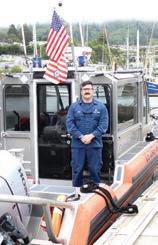
“We keep one boat in the house. This is our Ready Boat, so if we get a call they’re going to hop on and go,” explained Chief Joyce as he gave a tour of the boat. “They have a range of 200 nautical miles, easily. They can handle up to twenty-foot surf, thirty-foot waves and fifty knots of wind.”
According to the region’s website, their mission statement is: “We, the men and women of the U.S. Coast Guard Northwest District, provide critical maritime services within the Pacific Northwest. Our missions, maritime security, safety, and national defense, require superior professionalism, devotion to excellence and the highest standards of integrity. We pride ourselves in treating others with respect and dignity, facilitating partnerships with local, state and national agencies, and being innovative in our approach to meeting the region’s needs.” (www.pacificarea.uscg.mil/Our-Organization/District-13)
As the hub of activity at the District-13, Station Chetco River remains steadfast, so too is the commitment the service members of the Coast Guard give to our region, our country, our home.
We salute you and thank you.

PHOTO FROM U.S. COAST GUARD PETTY OFFICER 3RD CLASS ANNIKA HIRSCHLER Rear Adms. Arex B. Avanni, Joseph R. Buzzella, and Charles E. Fosse shake hands following the Coast Guard District Northwest change of command ceremony at Base Seattle, July 25, 2025. District Northwest includes more than 3,000 Coast Guard members, civilians, and auxiliaries operating across the Pacific Northwest and Inland Northwest.
U.S. Coast Guard Northwest District holds Change of Command ceremony
Rear Adm. Arex Avanni has assumed the duties and responsibilities of the U.S. Coast Guard’s Northwest District Commander from Rear Adm. Charles Fosse.
Rear Adm. Joseph Buzzella, acting commander, U.S. Coast Guard Pacific Area and Defense Force West, presided over the ceremony.
Avanni now assumes responsibility for all Coast Guard operations throughout the Northwest region which encompasses the states of Washington, Oregon, Idaho, and Montana. This area includes more than 4,400 miles of coastline, 600 miles of inland waterways, and a 125 nautical mile international border with Canada. He was previously the Deputy Director
of Operations for Headquarters, U.S. Northern Command in Colorado Springs, Colorado.
Fosse, who took command of the Northwest District in August 2023, is transferring to Coast Guard Headquarters in Washington, D.C., where he will serve as the Deputy Commandant for Personnel Readiness and Chief Human Capital Officer.
“It’s been an honor to serve the people of Coast Guard’s Northwest District over the past two years,” Fosse said. “The women and men who make up the Coast Guard here are absolute professionals who have worked tirelessly to rescue mariners in distress, safeguard our environment, and enforce maritime law at sea. This tour has been one of the most rewarding of my career.”
“I am excited to be the commander for the Coast Guard’s beautiful Northwest District,” Avann saidi. “I know our service members here are maritime experts that will continue to keep the American public safe, protect our natural resources, and remain ready to answer the call when disaster strikes.”
The change of command ceremony marks a transfer of total responsibility and authority from one individual to another. It is a time-honored tradition, conducted before the assembled crew, as well as honored guests and dignitaries to formally demonstrate the continuity of the authority within a command.
The U.S. Coast Guard Northwest District held the Change of Command ceremony at Base Seattle, Friday, July 25.

Rear
Rear
senior enlisted leaders render honors during the Coast Guard District Northwest change of command ceremony at Base Seattle, July 25, 2025. Avanni relieved Fosse as commander of District Northwest, which oversees Coast Guard operations across Washington, Oregon, Idaho, and Montana.
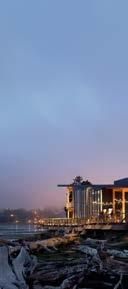




In the early 1980s, after a commercial fishing vessel went down off Newport and resulted in the loss of a life, members of the fishing community and local officials initiated a push for a Coast Guard helicopter to be stationed in Newport to respond to search and rescue missions in the area. There was already an air base in North Bend, but response times from that station to emergencies further up the coast were costing lives.
Finally, in March of 1986, then Oregon Gov. Vic Atiyeh lent his support to the effort, urging Congress to “see the federal commitment and appropriations necessary to ensure the establishment” of the air facility. Atiyeh cited a drowning of two young people swept of the rocks at Otter Rock, saying, “They drowned
while several hundred residents watched helplessly.” Congress appropriated the money in 1986, and although still technically part of Air Station North Bend, the Newport Air Facility was created to cut response time by having a helicopter stationed in Newport around the clock.
And then after about 28 years of providing this much needed service to the central Oregon coast, this protection was very nearly lost. It was a time when federal agencies at all levels were scrambling to find ways to cut their budgets. In a budget request for fiscal year 2014 to the U.S. Department of Homeland Security by the Coast Guard commandant, Admiral Robert Papp Jr., the following sentence was included: “The Coast Guard will also consolidate regional assets

A U.S. Coast Guard helicopter from the Newport Air Facility rescues a young girl at Yaquina Head in Newport, who was one several people swept to sea and stranded on the cliffs after being caught in a rip current while surfing at Agate Beach.
where overlapping capabilities exist by closing air facilities in Newport, Ore. and Charleston, S.C.”

The possibility of the Newport facility being closed quickly created an uproar in the local community, which was soon
echoed by state officials and Oregon’s federal legislators.
Led locally by the Newport Fishermen’s Wives Association, the effort included
condemnation by the city of Newport, Port of Newport, Lincoln County and the six Democrat members of the Oregon Congressional Delegation.
Ultimately, the Newport Air Facility was given new life when the U.S. Coast Guard Act of 2015 was passed by Congress and signed into law by President Barack Obama. That legislation guaranteed funding for a Coast Guard rescue helicopter in Newport through at least Jan. 1, 2018.
Obviously, that support still exists today because the needed funding remains, and it has been a decade now since the central coast nearly lost this much needed Coast Guard response capability. And over that 10-year period, there have been many rescues made and lives saved because that helicopter was ready to respond when needed.

U.S. Coast Guard Station Yaquina Bay has a long history in Newport — one that stretches well over a century. In fact, the first U.S. Lifesaving Service (the predecessor of the modern-day Coast Guard) opened a station at South Beach (now part of Newport) in 1896, then moved to its present-day location on the north side of the bay in 1906. The current facilities were erected in 1944, after the first building was destroyed by fire. A modern annex with berthing, dining, haul out facilities, as well as emergency power supplies, was completed in 1983. Work is currently underway to renovate and
restore buildings on the site as needed.
Station Yaquina Bay’s area of responsibility extends from Cape Perpetua on the south end to Spencer Creek on the north, totaling 27 miles of coast. With the primary mission of search and rescue, the station responds to hundreds of cases per year. In addition to search and rescue, another primary mission at Yaquina Bay is law enforcement.
When needed, Coast Guard crews will also assist police departments, fire departments, county search and rescue, and county marine patrol with emergency response.
The current commander

Surfmen are the Coast Guard’s best, most-highly trained lifeboat drivers, rated to power into 20-foot or higher waves. Slade spent seven years assigned to the National Motor Lifeboat School at Cape Disappointment, in Ilwaco, Washington, before receiving her next assignment in Newport, where she was operations officer and surfman trainer for five years.
take charge at Station Yaquina Bay.
of Station Yaquina Bay is Chief Warrant Officer Beth Slade, who has been with the Coast Guard for nearly
The U.S. Coast Guard is the oldest continuous seagoing service in the United States.
Coast Guard Day is held every August 4 to commemorate the founding of the United States Coast Guard as the Revenue Marine on August 4, 1790, by then-Secretary of the Treasury Alexander Hamilton, according to Wikipedia. On that date, U.S. Congress, guided by Hamilton, authorized the building of a fleet of the first ten Revenue Service cutters, whose responsibility would be enforcement of the first tariff laws enacted by the U.S. Congress under the U.S. Constitution.
The laws authorized the construction of 10 revenue cutters and the personnel to man them.
“The whole point was the fledgling nation needed an influx of money, so the revenue cutters were there to prevent smuggling and other illegal activities to make sure
the country was getting what it was owed,” according to a published interview in 2022 with Commander Michael Baird of Sector North Bend.
The U.S. Coast Guard, as it is known today, wasn’t created until 1915 when the Revenue Cutter Service and the U.S. Lifesaving Service merged.
“The merge created the U.S. Coast Guard,” Baird said, adding that the Coast Guard was then merged with the Lighthouse Service in 1939 and the Commerce Department’s Bureau of Marine Navigation in 1946.
Because the Coast Guard comprises so many other services, Baird said it is the reason for the Coast Guard’s 11 statutory missions.
“We don’t do just one thing,” he said.
Those 11 missions are: Port and Waterway Security, Drug Interdiction, Aids to Navigation, Search and Rescue, Living-Marine Resources, Marine Safety, Defense Readiness, Migrant Interdiction, Marine Environmental Protection, Ice Operations,
and Law Enforcement.
In addition, Baird said the Coast Guard has been part of every major conflict that the U.S. has fought.
“We’ve had people serve in every major war,” he said. “We’re at all times a military service. We’re part of the Department of Homeland Security to help us maintain our law enforcement aspects.”
Specific to the Oregon Coast, Sector North Bend was officially established in 2013. Prior to that it was Group North Bend, established in 1968.
“(But) when you look at North Bend’s Area of Operation, you can trace Coast Guard roots to 1870 with the Cape Blanco Lighthouse and 1878 with the first lifeboat station (which) was established in Coos Bay,” Baird said. “We changed to a sector because in order to better conduct our missions, we transitioned from groups to air sectors. A lot of titles changed over the years, but our presence and primary mission hasn’t changed too much.”
27 years.
Slade joined in September 1997 and was first assigned to the Mellon, a 378-foot cutter out of Seattle, then she spent a year at Station Woods Hole on the East Coast before deciding she wanted to be a surfman.
From there, Slade went to Station Depoe Bay as executive officer. When she received her commission as a warrant officer, she did her first tour as such on the same cutter where she started her career. She next took command at Station Golden Gate in San Francisco for three years and then did a four-year stint in command at Station Coos Bay before transferring to Newport to


Without a doubt, the Coast Guard has had a major impact on Newport and the surrounding communities, safeguarding life and property as part of its day-to-day mission. And the community supports its Coast Guard. In March of 2005, Newport was recognized as a Coast Guard City, a designation it still holds nearly two decades later.
On the city of Newport website, it states, “The men and woman of the Coast Guard are an important part of any community with strong economic ties to the oceans and waterways. We are fortunate to have these guardians in our community, and we are pleased to hold the honor of being a Coast Guard City.”


JEREMY C. RUARK Country Media, Inc.
U.S. Coast Guard Petty Officers Second Class Elijah Johnston is tasked with operating the Station Depoe Bay motorboats with a crew of four members.
“I am basically the boat captain,” he said.
Operating out of Depoe Bay can be challenging, according to Johnston.
“It has an absolutely tight harbor entrance,” he said. “It’s very narrow. It’s approximately 50-feet wide, which leaves narrow margins for error when you are transiting through there or towing another vessel, especially as the seas get bigger and the conditions become more challenging.”
The Fort Townsend, Wash. native has been a member of the Coast Guard for six years.
“I intend to be in the Coast
Guard for 20 years,” he said.
Johnston said he finds rewards as a Coast Guard member.
“The security for myself and my family,” he said. “Obviously its a good job. There are excellent benefits. It pays well and it provides for my family. There’s a sense of satisfaction when going out on the water, assisting mariners, saving lives, saving property and saving homes, and leading, empowering and developing and my crew.”
Johnston said the Coast Guard is a good place to be.
“The Coast Guard is always looking for young, able-bodied people who want to serve their country, get out on the water and do some good in the process,” he said. “My advice to somebody who wants to join is

JEREMY C. RUARK / COUNTRY MEDIA, INC.
U.S. Coast Guard Petty Officers Second Class Elijah Johnston takes a break on board one of the Depoe Bay Coast Guard vessels.
to do well in school. Don’t get in trouble. Don’t get on the wrong side of the law. Anybody who has the right mentality and is willing to work hard can get in. It’s very difficult to overcome those other things if you’ve made mistakes in your life.”
Johnston said the Coast
Guard has guided his life development.
“I was originally a high school dropout,” he said. “I went back to school when I was 20 years old and got my diploma. I think because of some of those earlier challenges, I wasn’t the greatest leader for a long time, but the service put me in a leadership position. I just didn’t have very good leadership skills.
I definitely faced challenges in inspiring and gaining the respect from the crew that I needed and just getting the job done.”
Station Depoe Bay was established in 1940 as a Search and Rescue motor lifeboat station.
The need for highly trained boat operators to conduct the many rescues through this inlet is what has made this Station a permanent fixture in this community.
The primary role of Station Depoe Bay is Search and Rescue with an emphasis in surf and heavy weather operations. As one of only 19 surf stations in the Coast Guard, Station Depoe Bay members train and operate in seas up to 30-feet, surf up to 20-feet
and sustained winds up to 50-knots. Those challenges require an extensive and robust training plan in order to certify the Coast Guard members to operate effectively in such conditions.
Federal laws and regulations also are enforced by the Coast Guard Station Depoe Bay members by conducting vessel boardings to ensure boaters meet all safety and navigation requirements. The members also respond to environmental hazards and accidents.
Station Depoe Bay utilizes three 47-foot Motor Lifeboats approved for operations in heavy weather and surf conditions. The station crews also can use ground vehicles for landside response during beach and cliff rescue operations.
This story was first published in July 2024.













